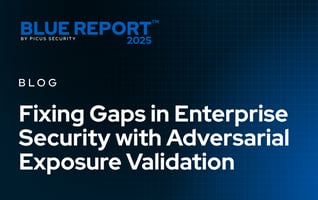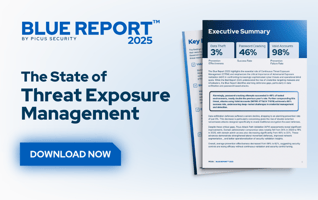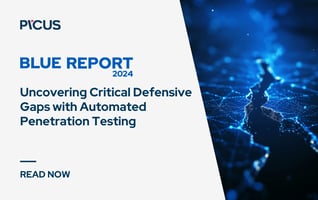Fixing Gaps in Enterprise Security with Adversarial Exposure Validation
In cybersecurity, deploying advanced security tools is only half the battle. Firewalls, SIEMs, endpoint protections, and cloud controls are essential, but their mere presence does not guarantee effective defense. The Picus Blue Report 2025 reveals a critical reality: organizations often overestimate their protection, with security controls frequently underperforming when tested against real-world attacks.
Across over 160 million attack simulations, Picus Labs found that organizations detect only one in seven attacks, despite having enterprise-grade security stacks. This gap between perceived and actual effectiveness highlights the importance of not only having the right tools in place but also actively validating their performance. Even the most sophisticated security infrastructure can silently fail if it isn’t tested against the threats it’s designed to stop.
Understanding Security Control Effectiveness
Security controls operate along two key dimensions: prevention and detection. Preventive controls, such as IPS, next-generation firewalls (NGFW), and WAFs, are designed to block attacks before they reach critical assets. Detection controls, including SIEMs, EDR platforms, and analytics tools, identify suspicious activity in real time so security teams can respond quickly.

The Blue Report 2025 reveals that, while preventive controls continue to block a significant portion of attacks, their effectiveness has declined slightly, dropping from 69% in 2024 to 62% in 2025. This demonstrates that even when systems appear well-configured, they degrade over time due to misconfigurations, policy drift, and evolving attacker tactics.


On the detection side, the report highlights mixed results. Log collection remained steady at 54%, meaning nearly half of attacker behaviors still go unrecorded. Meanwhile, alert scores rose modestly from 12% to 14%, indicating that less than one in seven attacks trigger actionable notifications. This persistent gap shows the difference between visibility and actionable intelligence, a gap that can be exploited by attackers if left unaddressed.
Why Controls Fail in Practice
Several factors contribute to the gap between deployed security controls and their actual effectiveness:
-
Configuration Drift: Over time, policies and thresholds often deviate from their intended setup due to software updates, changes in operational processes, or human error.
-
Integration Gaps: Security tools rarely function in isolation. Misalignment between SIEMs, endpoint detection, network controls, and cloud security can create blind spots.
-
Dynamic Threats: Attackers continuously evolve their techniques. A rule that successfully detected an attack last year may be blind to today’s stealthier, multi-step campaigns.

The Blue Report 2025 demonstrates this with empirical data: log collection issues accounted for 50% of detection rule failures, while misconfigurations and performance bottlenecks contributed 13% and 24%, respectively. These silent failures mean that even advanced controls can give the illusion of protection while allowing attackers to move laterally, escalate privileges, or exfiltrate sensitive data.
The Power of Adversarial Exposure Validation
To truly understand whether security controls are working, organizations need a way to test them against real-world attack scenarios. Adversarial Exposure Validation (AEV) provides this capability, simulating adversary tactics from credential theft and lateral movement to data exfiltration under realistic conditions. Unlike traditional audits or passive monitoring, AEV does not assume controls are effective; it proves whether they actually block attacks.
AEV provides organizations with actionable intelligence, revealing which SIEM rules, firewalls, endpoint protections, and policies are performing as intended and which are silently failing. For example, a firewall might appear correctly configured, but testing with AEV could expose paths that allow lateral movement or sensitive data to leave the network. By uncovering these gaps, security teams can tune controls with confidence, ensuring that their defenses reflect reality, not assumptions.
Tuning Security Controls Through CTEM
Validation alone is not enough. Organizations must act on findings through Continuous Threat Exposure Management (CTEM), an operational framework that formalizes the cycle of testing, tuning, and monitoring security controls.
Once weaknesses are identified, SIEM rules can be adjusted to improve thresholds, refine correlation logic, and optimize filters. Endpoint protections should be configured to detect high-risk behaviors like lateral movement, privilege escalation, and exfiltration. Firewalls and network segmentation policies can be fine-tuned to prevent unauthorized movement while ensuring business continuity.
CTEM makes this process iterative. Teams identify gaps, validate fixes, monitor outcomes, and repeat. This continuous approach allows organizations to adapt defenses proactively as adversaries evolve, ensuring that controls maintain their effectiveness over time.
Practical Benefits of AEV and CTEM in Real-World Security
Organizations that integrate Adversarial Exposure Validation (AEV) and Continuous Threat Exposure Management (CTEM) gain tangible, measurable advantages. Validation ensures that security rules detect real attacks, not just theoretical vulnerabilities, while simulating adversary behaviors uncovers hidden gaps across endpoints, networks, and cloud environments. Properly tuned alerts enable security teams to respond faster, reducing dwell time and improving incident response. Moreover, the Blue Report 2025 findings show that teams should prioritize remediation based on the most impactful gaps, rather than dispersing resources on lower-risk issues.
The report provides concrete evidence of the consequences when controls are left unvalidated. Organizations detected only 1 out of 7 simulated attacks, highlighting that even active SIEM rules can fail silently in practice. Password cracking succeeded in 46% of environments, and Valid Accounts (T1078) were exploited in 98% of cases, revealing persistent weaknesses in credential security. Many controls were also bypassed during lateral movement, allowing attackers to navigate networks and access sensitive systems undetected. Misconfigured SIEM rules, incomplete log collection, and inefficient policies further reduce alerts and undermine detection efficacy.
Together, these findings emphasize that security controls cannot be assumed effective based solely on their presence or lab performance. By leveraging AEV and embedding it into CTEM practices, organizations can continuously test, tune, and validate their defenses, ensuring that detection rules, endpoint protections, and network controls remain resilient against evolving adversary techniques. Validation transforms assumptions into actionable insights, allowing security teams to confirm what works, prioritize improvements, and mitigate the risks that truly matter.
Closing the Gap with Validation
Security controls may appear functional, but the Blue Report 2025 shows that many fail silently, leaving critical systems exposed. Integrating Adversarial Exposure Validation (AEV) into Continuous Threat Exposure Management (CTEM) allows organizations to uncover hidden gaps, fine-tune controls, and maintain operational effectiveness even as threats evolve.
See where your defenses are actually working and where they might be silently failing. Download the Blue Report 2025 today to gain actionable insights and practical recommendations for validating and optimizing your security controls.








